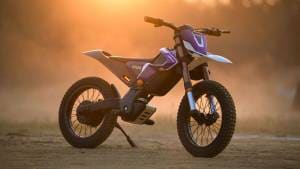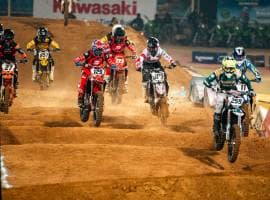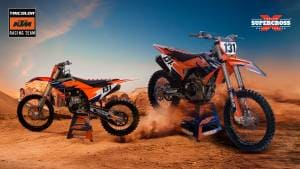Dakar 2019 round up: None but the brave
How do they do it? It's a question that I keep asking myself when I watch clips of the 2019 Dakar Rally. Videos of stricken cars in the dunes of the Peruvian desert, lying on their sides, seemingly at the end of their journey. Only, they aren't. Soon, drivers and navigators scramble out, check themselves for injuries, and once they've managed to gather their thoughts, they dust the sand off, right their stricken machines, and carry on till the end of the stage. Riders have an even harder task, having to tackle the treacherous terrain, often getting lost in the desolate sands all on their own. Sometimes having to pick their motorcycles up multiple times, fighting exhaustion, fighting injury, fighting the urge to just give up. How, indeed, do they do it?
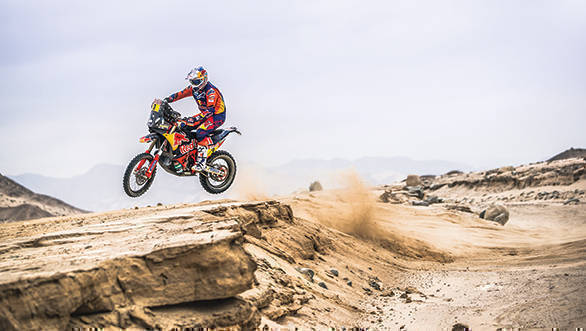 Toby Price leaping his way to a second Dakar victory
Toby Price leaping his way to a second Dakar victory
We'd all like to think that we have a high threshold for pain. Bravado that lasts until we stub one of our toes, and come crashing back down to a very agonising reality. Which is why it's hard to understand just what Australian rider, Toby Price, is made of. Adamantium, perhaps? Fictional metal alloys aside, the KTM Factory Racing rider managed to do something pretty unbelievable at the 2019 Dakar. See, while training for the rigours of the Dakar, in December 2018, Price crashed and broke his right scaphoid. Now, broken bones in general are a big deal. But riding while the bones in one's throttle hand are broken, during a rally that covers 5,000km over the course of 10 days? To say that is a huge deal, is an understatement. And to win the Dakar in that condition? Now that is an achievement of monumental proportions. And Toby Price is a remarkable person, with seemingly infinite courage.
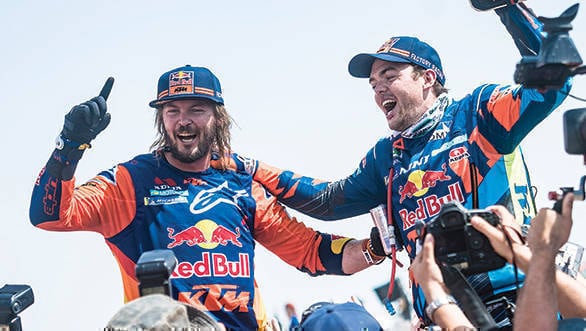 Price, seen here celebrating with team-mate Matthias Walkner, who won the Dakar in 2018
Price, seen here celebrating with team-mate Matthias Walkner, who won the Dakar in 2018
In December, after breaking his scaphoid, Price had emergency surgery, then went back home to Australia for a few days of rest, and then it was straight to Peru for the 31-year old, where, after 10 very demanding stages, he won the 2019 Dakar. As you can imagine, though, it wasn't easy going at all. In fact, Price managed to surprise himself, given that he initially thought he was only likely to make it through the first three stages of the rally, after which he would bow out, succumbing to the pain of his injury. But he didn't. Instead, he gritted his teeth and rode on. When he wasn't able to use his right hand any longer, he reached over and twisted the throttle with his left hand. And when even that was impossible to manage, during the long transport sections of the rally, he rigged a little something up, using bits from the KTM 450 Rally's battery cage, that helped stick the throttle open, allowing him to rest his right hand a little. And, eventually, on the eighth stage of the rally, Price found himself leading the 2019 Dakar. The rest, already, is history.
It was a weary Price who emerged from battle at the podium in Lima. "Pretty much all I can say is that it feels like there are about five people driving a knife in my wrist now," he said. But, it was a small price (pun intended) to pay for his second Dakar win. What was on his mind, however, was that he needed to go back home and get his wrist checked out to ensure that there wasn't any permanent damage to it. But not before he allowed KTM stablemate, the fierce Laia Sanz (who rode to an eleventh place finish herself, and won a bet that they'd made) to shave his head.
Oh, and just in case you thought that Price winning the Dakar wasn't a big deal, we'd just like to remind you that he's made heroic victories something of a habit. Back in April 2013, Price crashed during a race, ending up with three broken vertebrae in his neck, and narrowly avoiding paralysis to all four limbs. Three years later, in January 2016, he became the first Australian rider ever to win the Dakar Rally. That adamantium theory is beginning to sound more plausible by the minute!
Let's not forget
The 2019 Dakar, more so than other editions of the event in recent times, was a rally of attrition. Competitors dropped by the wayside on nearly every single stage of the event. And it all began with Joan Barreda Bort.
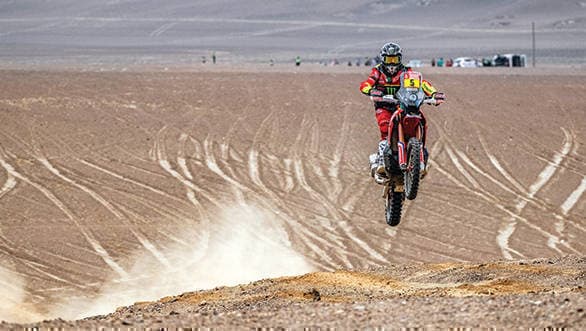 Joan Barreda Bort flies through the air on the No.5 Honda CRF 450 Rally. It looked like it might finally be his year, but after winning the first two stages of the Dakar, Bort bowed out on the third stage
Joan Barreda Bort flies through the air on the No.5 Honda CRF 450 Rally. It looked like it might finally be his year, but after winning the first two stages of the Dakar, Bort bowed out on the third stage
The Spanish rider led the overall rankings after two stage wins. But in the third stage, fog meant that Bort ended up at the bottom of a ravine, from which he couldn't extricate himself, ending his rally. On the eighth stage of the rally, Bort's Honda Racing Corporation teammate Ricky Brabec retired with a blown engine while in the lead of the rally.
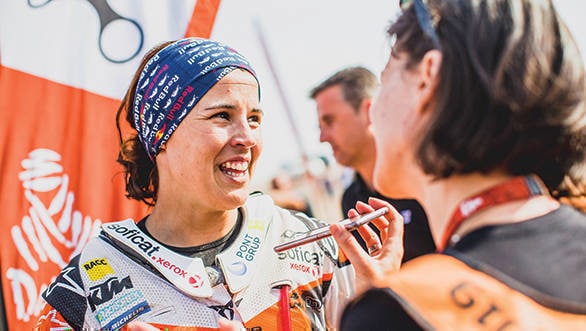 KTM's Laia Sanz battled through the Dakar with almost no training after suffering from Q fever. She finished 11th.
KTM's Laia Sanz battled through the Dakar with almost no training after suffering from Q fever. She finished 11th.
Yamaha's Adrien Van Beveren retired on the penultimate stage of the rally. While Pablo Quintanilla suffered a crash on the very last stage of the rally, preventing him for taking his maiden Dakar victory astride the Husqvarna. He was also denied third place overall, when a penalty for Sam Sunderland was reversed, allowing the 2017 winner Sam Sunderland to take the final podium spot. With defending champion Matthias Walkner, finishing as runner-up, it was an all-KTM podium, and the Austrian team's 18th Dakar consecutive Dakar win.
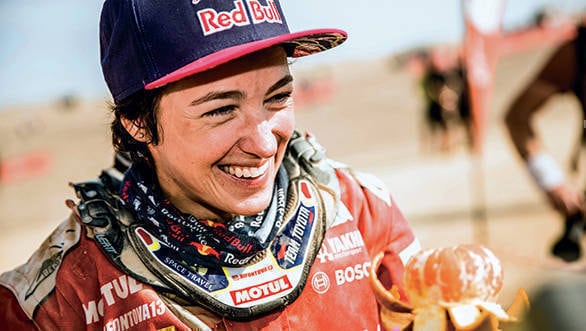 In 2019 Anastasiya Nifontova became the first woman to finish the Originals by Motul (Malle Moto) class of the Dakar Rally
In 2019 Anastasiya Nifontova became the first woman to finish the Originals by Motul (Malle Moto) class of the Dakar Rally
Target acquired
You've got to be a pretty accomplished sort of individual if you can say that you've won an Olympic bronze medal in skeet shooting, claimed two Production World Rally Championship titles, and also managed to win that most daunting of all cross country rally raids - the Dakar - not once, not twice, but three times. Enter Nasser Al-Attiyah. A pretty accomplished sort of individual indeed.
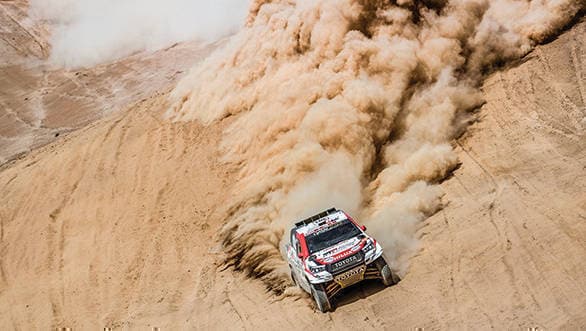 Nasser Al-Attiyah took a flawless victory in the Car category of the 2019 Dakar, taking his tally up to three in total.
Nasser Al-Attiyah took a flawless victory in the Car category of the 2019 Dakar, taking his tally up to three in total.
At the 2019 Dakar Rally, an event that saw several big names caught out by driving errors, navigational errors, and mechanical issues, the combination of Al-Attiyah, navigator Mathieu Baumel, and the Toyota Gazoo Racing Hilux was magical. It was almost as if the Prince of the Desert, a well-deserved moniker for the Qatari dune expert, could do no wrong.
While the lead at the top of the overall rankings seemed to change every second day in the Moto category, it was another story entirely in the Cars class. Al-Attiyah took the overall lead on the first day of the 2019 Dakar, and save for the second day, when he briefly relinquished his hold at the top of the timing sheets, he led all through. Perhaps defending champion Carlos Sainz was right after all. When Al-Attiyah took victory in the first stage, his Spanish rival, behind the wheel of the X-Raid Mini Buggy said that he believed it was the Toyota driver who was now the clear favourite for victory. After all, with 70 per cent of the rally being run in sand and in the dunes, it was home turf for Al-Attiyah. Perhaps the only glitch that came up was on the eighth stage of the rally, when Al-Attiyah lost time due to a puncture on his Hilux. Given that there was just 10km left till the end of the stage, instead of stopping to change the tyre and losing time in the process, he carried on driving till the end of the stage, even though all that was left was the rim.
 Nasser Al-Attiyah celebrating his third Dakar win that he scored with victory in 2019
Nasser Al-Attiyah celebrating his third Dakar win that he scored with victory in 2019
Al-Attiyah's third Dakar win (he won with Volkswagen in 2011 and with Mini in 2015) is also Toyota's first victory at the epic marathon, despite the fact that they've entered the event more times than any other manufacturer. And he's pretty pleased with the fact that his popularity, in the wake of his win, will soar in Japan. Not just because he wants to increase the support he will receive for Dakar 2020. But also because once that's done, he's going to dust off his rifle, and compete at the Summer Olympics in Tokyo. More trophies and medals to aim for after all.
Let's not forget
The way Al-Attiyah won the 2019 Dakar almost makes it seem like it was a one horse race. Except that it really wasn't. To begin with, Sainz trailed Al-Attiyah by under two minutes on the first stage, and under five minutes at the end of the second stage. But, disaster struck on the third stage. An issue with the roadbook meant that Sainz found himself in an unexpected ravine, resulting in a broken wheel. At the end of the stage, he was ranked 36th overall, over 4hr 15min adrift of the overall leader - the end of his Dakar title hopes.
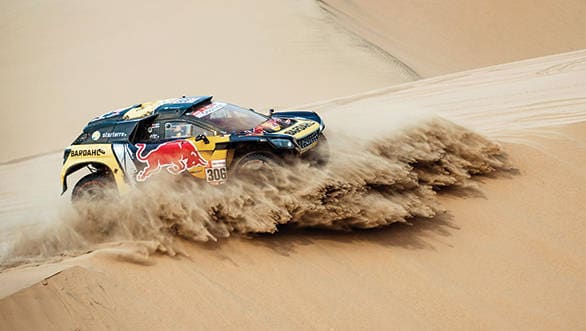 Sebastien Loeb in the No.306 PH Sport Peugeot 3008 DKR tried his best to stop him. But it wasn't to be
Sebastien Loeb in the No.306 PH Sport Peugeot 3008 DKR tried his best to stop him. But it wasn't to be
Sebastien Loeb won four stages, despite issues with the roadbook and with his PH Sport Peugeot 3008DK. And he climbed to 46min 45sec of Al-Attiyah's time by the end of the eighth stage, but things came undone for him once again on the ninth stage. Loeb's car stopped towards the end of the stage, effectively ending any hope of winning the Dakar. Thirteen-time Dakar winner Stephane Peterhansel, also retired on the ninth stage, with his navigator injuring his back and having to be airlifted to a hospital in Lima. Cyril Despres rolled his X-Raid Mini towards the end of the stage too. The only hope for the competition, was if Al-Attiyah were to crash out of the rally, which as we know didn't happen. Nani Roma, driving an X-Raid JCW Mini ended the rally second, with Loeb taking his third Dakar podium in three years.
Holy truck!
Since they first won the truck category of the Dakar in 1996, Kamaz has had a pretty solid run at the greatest rally raid in the world. Most famously with Vladimir 'Tsar of Dakar' Chagin. The seven-time Dakar winner no longer drives, but heads the rally operations for Kamaz, and he's doing a pretty good job of it, if you ask us. After all, even without Chagin behind the wheel, with the exception of two years (2012 and 2016) when Iveco's Gerard de Rooy won, Kamaz has continued to dominate the Dakar.
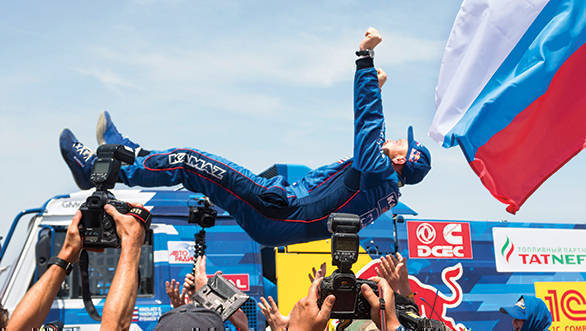
Eduard Nikolaev took his first Dakar victory in 2010 as a mechanic for Chagin, and followed that up with his first victory as a driver in 2013. It was his teammates Andrey Karginov and Ayrat Mardeev who took victory at the two subsequent editions of the Dakar, but Nikolaev dominated once again in 2017, 2018, and rounded off a hattrick with victory at the 2019 edition.
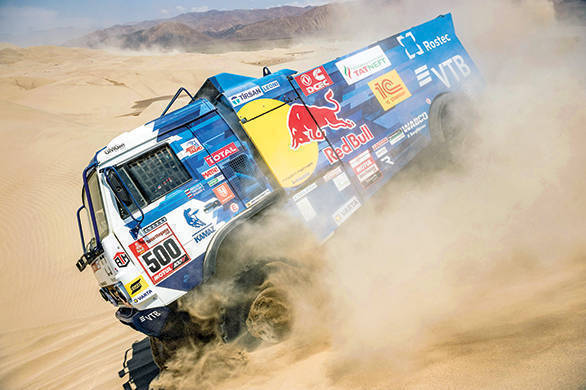 The Dakar wouldn't be the Dakar without a big blue and white Kamaz battling through treacherous terrain. Eduard Nikolaev must be getting used to being thrown up into the air as part of his victory celebrations(above). Dakar win No.4 in this case!
The Dakar wouldn't be the Dakar without a big blue and white Kamaz battling through treacherous terrain. Eduard Nikolaev must be getting used to being thrown up into the air as part of his victory celebrations(above). Dakar win No.4 in this case!
While Nikolaev began the 2019 Dakar well, winning the first two stages, things got tricky after that. But he recovered well, taking a formidable win on the ninth and 10th stage of the rally, and then stepping smartly onto the top step of the podium in Lima. With four Dakar wins under his belt, Nikolaev could well gun for Chagin's record. Time will tell. But in the meanwhile, we're happy to watch those blue and white Kamaz rally trucks leaping over sand dunes, and managing impossible feats for vehicles that size!
Let's not forget
It wasn't a smooth run to the finish line for Nikolaev. The Russian driver had stiff competition, mainly in the form of his own teammates. 2014 winner, Andrey Karginov staked his claim to the Dakar title, but was disqualified from the event for a collision with a spectator. The organisers of the event stated that Karginov ought to have stopped to help the injured person, but Karginov and his crew simply had no idea that their back wheel had run over anyone at all. There's a somewhat terrifying video clip of the collision, that you ought to look up. If that isn't a cautionary tale for motorsport spectators around the world, we don't know what is. Then there was the other Kamaz of Dmitry Sotnikov. In fact he did such a good job, he even took the overall lead of the rally away from Nikolaev with two stages to go. But Nikolaev, as we know, made a comeback, forcing Sotnikov to second overall. Iveco's de Rooy had to be content with third overall.
And those other four-wheelers
The Quad category of the Dakar is usually closely contested, and tends to make for entertaining watching. With defending champion Ignacio Casale (versatile chap that he is, having also competed in the Dakar on a motorcycle and in trucks) having switched to the SxS class this year, the field was open for last year's runner-up Nicolas Cavigliasso.
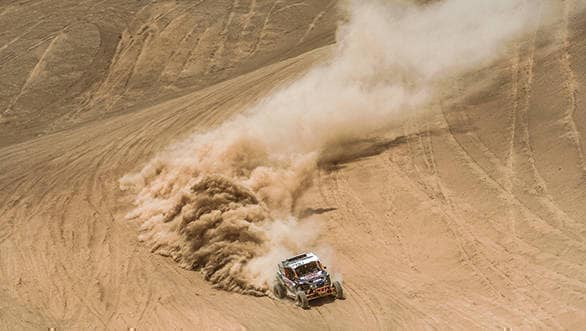 Former participant in the Moto class, Chaleco Lopez made a smooth transition to the SxS category, taking a commanding win in his debut attempt in the side by sides. Seen here leaving a trail of sand in his wake in the Peruvian desert.
Former participant in the Moto class, Chaleco Lopez made a smooth transition to the SxS category, taking a commanding win in his debut attempt in the side by sides. Seen here leaving a trail of sand in his wake in the Peruvian desert.
The Argentine rider, competing astride a Drag'on Rally Team Yamaha Raptor 700R, won all but one stage of the event. Jeremias Gonzalez, who denied Cavigliasso victory on Stage 3, finished runner-up, while Alexandre Giroud finished third. The 30-team strong SxS class, now in its third year, saw a fine victor in the form of Francisco 'Chaleco' Lopez. Chaleco, who has taken part in the Dakar in the Moto class in the past, won his maiden attempt in the side by sides. Finishing second overall was Gerard Farres, also usually used to competing in the Dakar on two wheels. While defending champion Reinaldo Varela had to settle for third place overall.
THE BIVOUAC
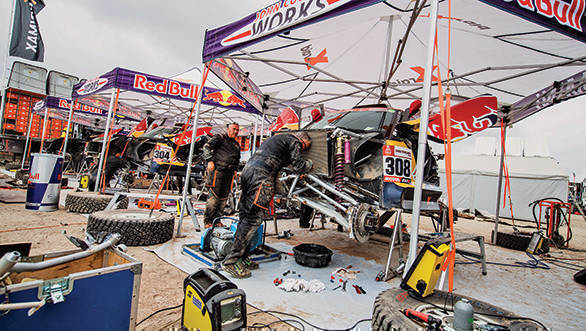
The bivouac is the camp where the rally comes each night to lick its wounds. Usually, the bivouac is designed to be wrapped up and moved within the matter of a couple of hours because it has to travel with the rally. So all the structures are temporary, including the PCO, where the race is controlled from. Each team has an assigned space where their race and assistance vehicles go and most teams arrange sleeping accommodations within this space - usually a motorhome. Common areas include the laundry (yes!), a place to wash the vehicles down, toilets, the Comedor, the Dakar Club (a place to chill with cold and hot drinks), the showers and the refuelling area. Access to the Bivouac is tightly controlled so most of the time, a small city of sorts springs up across the road from it too - selling necessities, merchandise, food, drink and more.
FOOD AT THE DAKAR CAMP

The Comedor is the restaurant at the Dakar. It's a large hall with two buffets - one for racers and assistance crews and the other for everyone else. The spread usually includes a cold salad, some soup, a main dish, bread and usually, pasta. At the end you can collect a soda, water or beer. The food is generally hot, hearty and filling and you can have as much as you can eat. There is also always hot coffee and tea, naturally. And on some days, in addition to the dessert, you can also have ice cream. What makes the Comedor even more fun apart from the fact that you're eating with the Dakar stars is the super upbeat music that's usually playing. And you have to tip your hat to the enthusiastic, ever-smiling Peruvian boys and girls who serve you. Their energy is contagious and it makes the Comedor extremely welcoming at the end of a long day.
THE ROAD BOOK
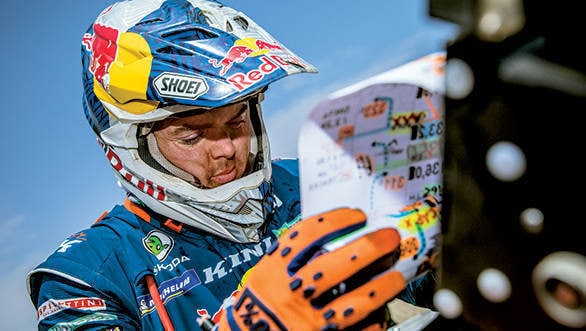
This is the centrepiece of the navigation system. For the bikes, it's a roll of paper divided into three columns. Cars and trucks get a spiral bound notepad. Each row is a set with the left column, reading out a kilometre reading (say, 51.74), the middle column has a graphic that explains what to expect and the final column has notes - like rocks, undulations, waypoints etc. For the Dakar, the roadbook is in French and it's a language of sorts. Each rider or navigator will usually mark the roadbook with a highlighter to ensure that all the important things are easily readable. The roadbook also has a degree figure, usually in blue ink. This is the cap, or the direction you're supposed to take. This is how you keep on the track. Sometimes, one row can have multiple caps - 34 degrees for 2.4km and then 188 degrees for the next 3km, for example. Zero or 360 means directly north. Getting lost means you won't hit a waypoint and if you don't hit a waypoint, the race GPS screen will not wake up and give you the next cap, crucial for the rest of the roadbook to make sense.
